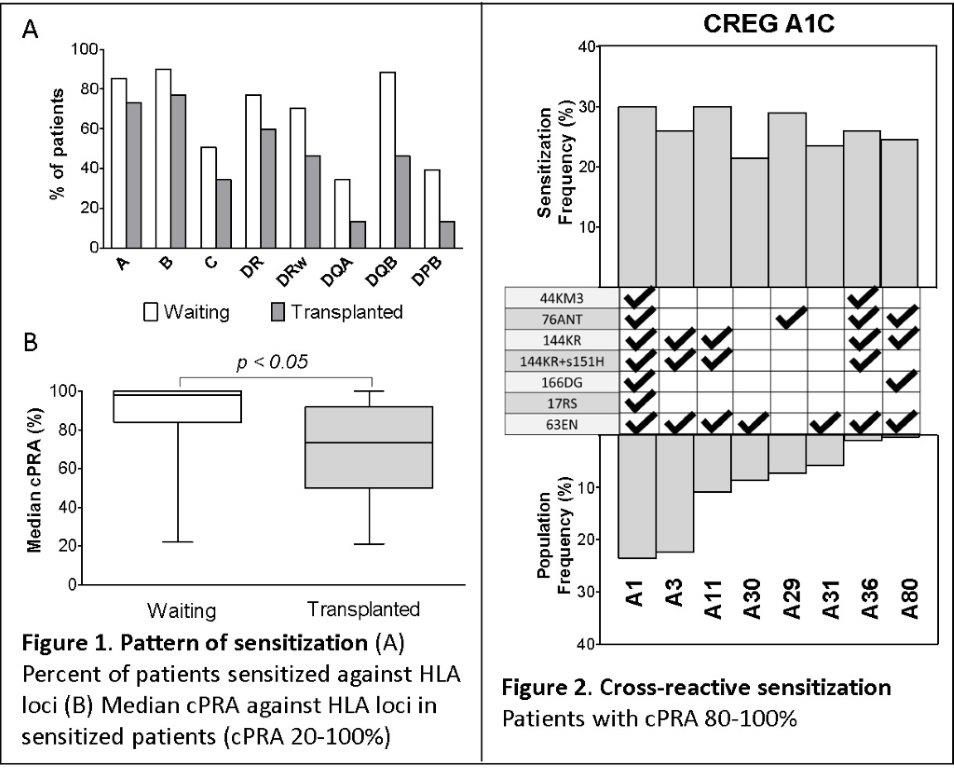Shared Epitopes Contribute to Accumulation of Highly Sensitized Patients in Kidney Paired Donation Program.
University of Toledo, Toledo, OH
Meeting: 2017 American Transplant Congress
Abstract number: 54
Keywords: Epitopes, Kidney transplantation, Sensitization
Session Information
Session Name: Concurrent Session: Kidney Living Donor Evaluation and Recruitment
Session Type: Concurrent Session
Date: Sunday, April 30, 2017
Session Time: 2:30pm-4:00pm
 Presentation Time: 2:30pm-2:42pm
Presentation Time: 2:30pm-2:42pm
Location: E450a
Introduction: Kidney Paired Donation (KPD) programs suffer from the accumulation of highly sensitized patients. We evaluated the sensitization patterns in our KPD program-by comparison of waiting versus transplanted patients. Methods/Results: We analyzed our KPD database of unacceptable antigens (UA) reported by transplant centers. Patterns of sensitization against HLAs were examined in a group of patients (cPRA 20-100%). Notably, sensitized waiting patients (n=673) had IgG against HLA-A (85%), -B (90%), -C (51%), -DR (77%), DQB (89%), -DQA (34%) and -DPB (39%). In contrast, transplanted patients (n=196) were always less sensitized (Fig. 1A). Median cPRA values confirmed that waiting patients had significantly higher sensitization levels (median cPRA=99%) than their transplanted counterparts (median cPRA=78%; p<0.05; Fig. 1B). Thus, our KPD computer program is skewing by selecting less sensitized individuals for transplantation. This process is responsible for accumulation of highly sensitized patients (median cPRAs of >95%). The same pattern was confirmed for each individual HLA loci. We also analyzed the UAs of 418 highly sensitized patients (cPRA 80-100%): patients with IgG to HLA-A1 of a cross-reactive group A1C (CREG-A1C) had similar IgG levels to all HLAs within the CREG-A1C (Fig. 2). In this fashion highly frequent in population HLA-A1 generated IgG specific not only to itself but to all less frequent HLAs within the CREG-A1C. We showed a similar pattern for multiple Class I and for Class II cross-reactive antigens. Finally, we defined epitopes (Epitope Registry) for every cross-reactive group and present an example for CREG-A1C (Fig. 2). Conclusions: 1) APD accumulates highly sensitized patients; 2) cross-reactivities within HLAs of Class I and Class II contribute to a wide-spread sensitization in highly sensitized patients; and 3) shared epitopes among HLAs are responsible for this broad sensitization.
CITATION INFORMATION: Stepkowski S, Mierzejewska B, Baum C, Bekbolsynov D, Brunner R, Kopke J, Rees S, Rees M. Shared Epitopes Contribute to Accumulation of Highly Sensitized Patients in Kidney Paired Donation Program. Am J Transplant. 2017;17 (suppl 3).
To cite this abstract in AMA style:
Stepkowski S, Mierzejewska B, Baum C, Bekbolsynov D, Brunner R, Kopke J, Rees S, Rees M. Shared Epitopes Contribute to Accumulation of Highly Sensitized Patients in Kidney Paired Donation Program. [abstract]. Am J Transplant. 2017; 17 (suppl 3). https://atcmeetingabstracts.com/abstract/shared-epitopes-contribute-to-accumulation-of-highly-sensitized-patients-in-kidney-paired-donation-program/. Accessed December 13, 2025.« Back to 2017 American Transplant Congress
